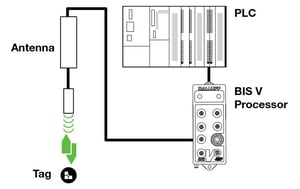There has been a lot of talk in the industrial automation about RFID. In past blog posts we’ve discussed topics like RFID ROI and when to use IO-Link RFID. We could talk about things to consider when implementing RFID into your plant or different applications for days. In this entry, though, I’d like to get back to the basics a little bit.
Area of Application for a Passive RFID System:
RFID is used to accurately identify an object on which the tag is placed. In addition to identification, bject-specific information, like maintenance data is contained on the tag.
 Typical RFID System
Typical RFID System
How It Works:
Since passive RFID tags contain no battery, the tag is powered up or “woke up” by the RF waves emitted from antenna of the same frequency. Once a tag is located in range it is powered up by the antenna and its memory can be read and transmitted to the processor. The time it takes the reader to extract information from the tag is usually measured in milliseconds.
Three Main Components of a Passive RFID System:
To learn more about industrial RFID applications and components visit www.balluff.com



























